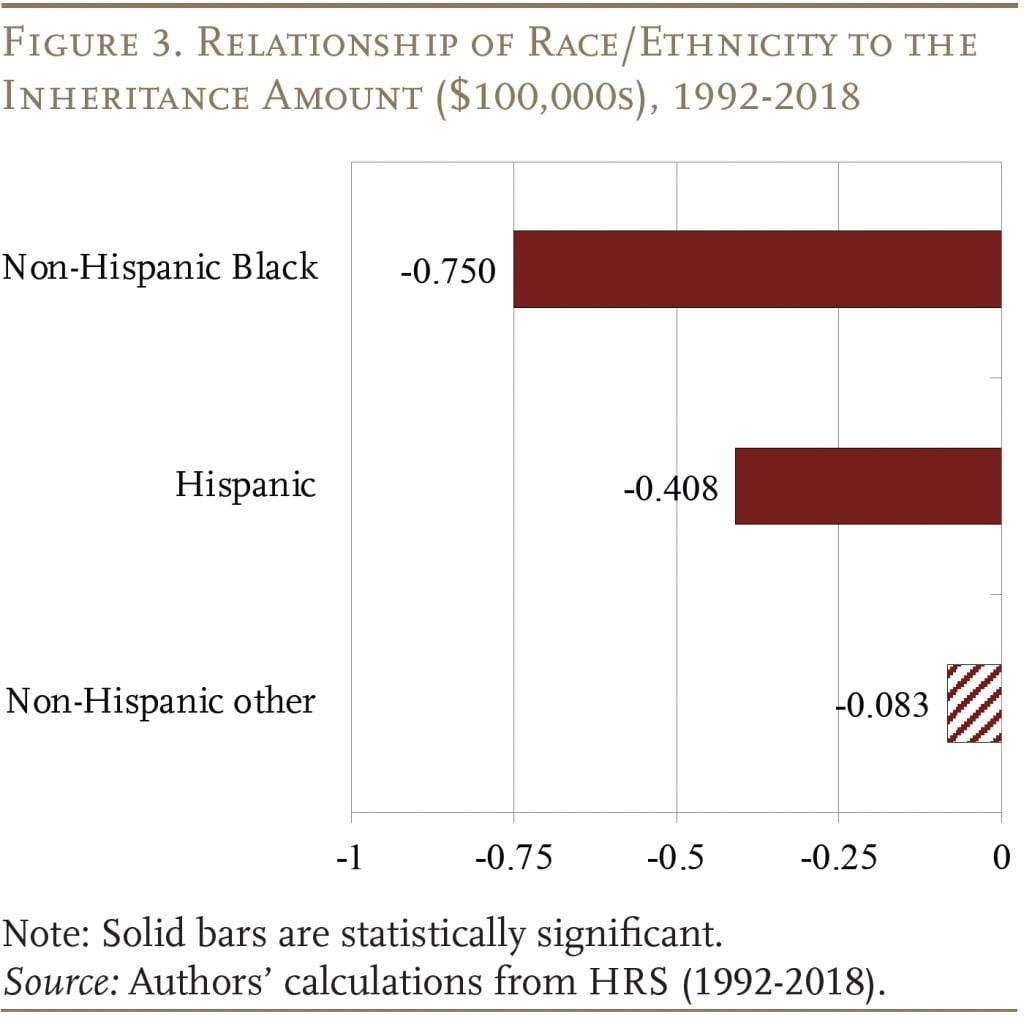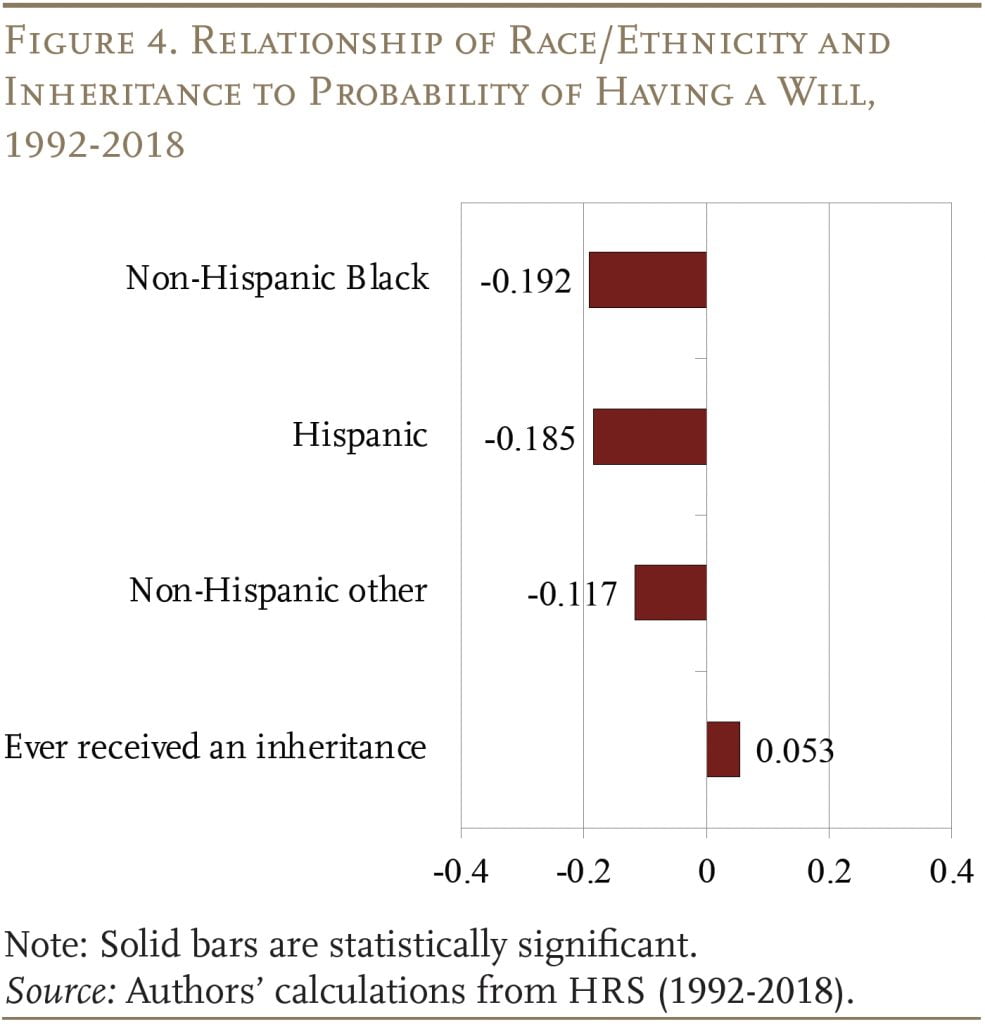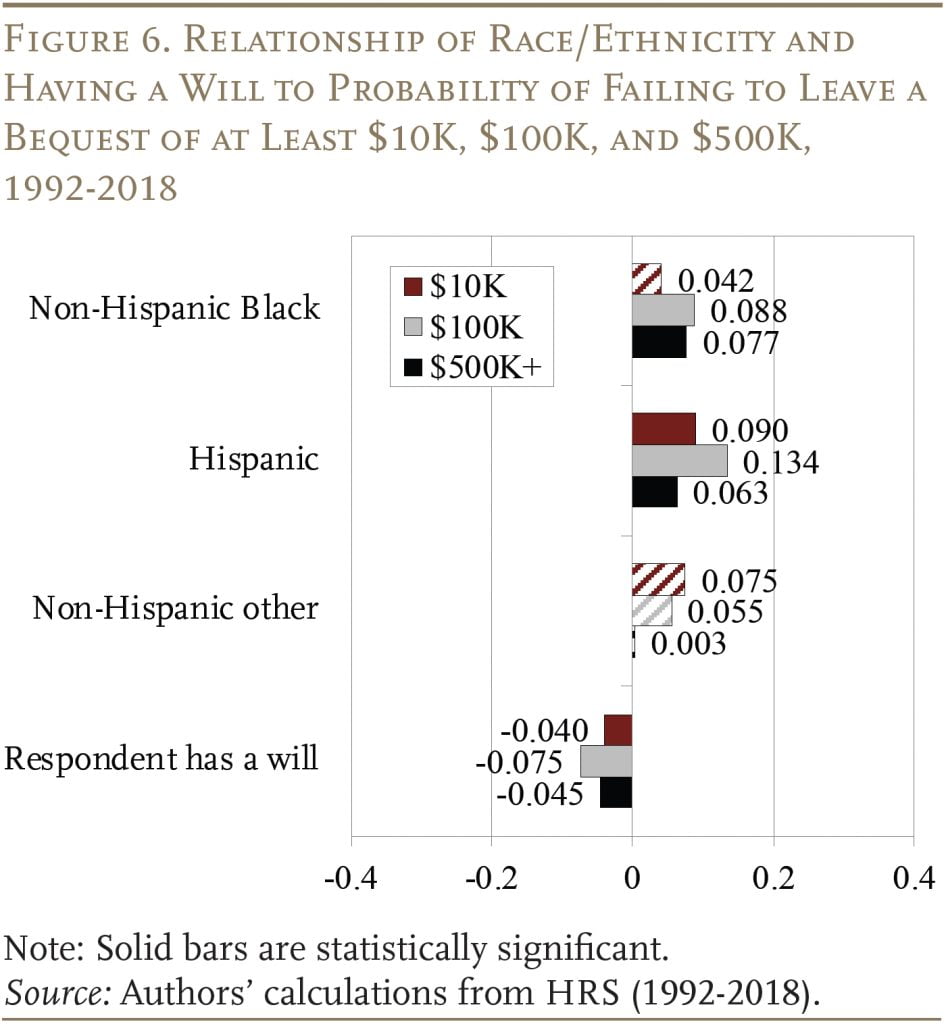The transient’s key findings are:
- The evaluation explores how receiving an inheritance, having a will, and planning and realizing a bequest are interrelated and fluctuate by race.
- Black and Hispanic people are much less prone to get an inheritance, have a will, and plan to depart a bequest.
- Amongst those that do plan to depart a bequest, Black and Hispanic people are much less prone to notice their bequest goal.
- Nevertheless, having a will will increase the possibilities of reaching one’s bequest goal, providing a possible manner to enhance the state of affairs.
Introduction
Inheritances make up a considerable share of nationwide wealth, however are sometimes ignored in discussions of retirement safety. Racial gaps in inheritances are prone to exacerbate racial disparities in wealth. One purpose that Black and Hispanic decedents are much less prone to go down significant estates is that they’re far much less prone to have a will than Whites.
This transient, which is predicated on a latest paper, makes use of the Well being and Retirement Research (HRS) to doc how the chance of receiving an inheritance, the plan to depart a bequest, having a will, and precise bequests fluctuate by race and the way the 4 are interrelated. That’s, to what extent does receiving an inheritance improve the chance of planning to depart a bequest and having a will, and to what extent does having a will relate to the conclusion of bequest expectations? Particularly, the evaluation makes use of the HRS exit interviews of proxy informants for HRS members who’ve died to discover whether or not the existence of a will impacts the extent to which bequest intentions are literally realized.
The dialogue proceeds as follows. The primary part discusses why wills are necessary. The second describes the information and strategies of the evaluation. The third part summarizes the elements affecting the chance of receiving an inheritance, the plan to depart a bequest of at the very least $10,000, $100,000, and $500,000, and the presence of a will. The fourth part turns to the outcomes that relate bequest expectations to realized bequests to see whether or not expectations are an excellent predictor of actual outcomes and the way that relationship is affected by the presence of a will and the race of the person. The ultimate part concludes that race is strongly correlated with the chance of getting acquired an inheritance, of getting a will, and of leaving a bequest, whereas wills are positively associated to the chance that bequest expectations develop into actuality.
Why Are Wills Essential?
The Courts have decided that the U.S. Structure protects the precise of individuals to depart their property to whomever they need. Nevertheless, with out a will, property can get dispersed to unintended recipients. This end result is usually a specific downside for individuals with modest estates, the place the most important asset is the house and a number of heirs can result in the fractionalization of the property.
Within the absence of a will, the distribution of a decedent’s property is set by state intestacy regulation, which varies from one state to a different. The process is designed to seize the possible intent of most individuals; and asset distribution typically proceeds within the following order: 1) surviving partner; 2) descendants; 3) dad and mom; 4) siblings; and 5) different kinfolk akin to grandparents, cousins, and nephews.
Whereas the target of the default guidelines is to distribute a decedent’s property in keeping with their possible intent, the regulation’s choice for “conventional” household constructions is at odds with the rising prevalence of nontraditional households. Shares of cohabiting and single-headed households have elevated; the share of nonmarital little one delivery has risen; and grandparents are more and more caring for grandchildren.
Estimates present that the default provisions are usually not applicable for 22 % of households, and that the chance of being marginalized by the defaults is positively associated to being Black or Hispanic and negatively associated to web value and training. Briefly, dying with out a will could also be tremendous for almost all of households headed by a married couple or for a lot of single people, but it surely can lead to the fallacious end result when the supposed beneficiaries are usually not associated by blood, marriage, or formal adoption.
Dying intestate is a specific downside when the property is modest and the most important asset is the house. The chance is that the house descends to a number of heirs, and all of the tenants in frequent should coordinate and procure consent from fractional house owners earlier than sustaining or promoting the property. If the supposed beneficiaries live within the decedent’s residence, the distribution to numerous beneficiaries may consequence within the compelled sale of the property and go away them homeless. Regardless of the significance of wills for preserving the worth of a bequest, above and past their significance in transmitting it to supposed heirs, solely about two-thirds of households ages 70+ have a will, and that proportion has been declining over time (see Determine 1).

Knowledge and Strategies
The evaluation of bequests and bequest expectations throughout years is predicated on information from the HRS for 1992-2018. The HRS is a panel survey that follows People over age 50 and their spouses over time, interviewing them each two years.
The HRS tracks a number of variables of curiosity. Importantly for this evaluation, the survey elicits respondent self-reported chances of leaving a bequest of at the very least $10,000, $100,000, and $500,000. The survey additionally asks whether or not a respondent has acquired an inheritance at any level (and the way a lot that inheritance was value) and whether or not a respondent has a will. Respondents are additionally requested about a wide selection of socioeconomic and demographic traits, together with asset holdings and family construction. The HRS additionally conducts proxy exit interviews that present details about precise property execution for panel members who’ve died.
The HRS information are first utilized in regressions to look at the connection between the chance of getting acquired an inheritance, the chance of getting a will, and the self-reported chances of leaving a bequest, controlling for socioeconomic elements together with race, wealth, training, intercourse, age, marital standing, and well being. The position of race is of specific curiosity; respondents are separated into racial/ethnic teams: non-Hispanic White, non-Hispanic Black, Hispanic, and non-Hispanic different.
After these preliminary equations, the HRS exit interviews are used to check the hyperlink between supposed and realized bequests, with a deal with race/ethnicity and the position of wills. This evaluation includes estimating the next equation:
Bequest quantity = ƒ(Race/ethnicity, Will, Socioeconomic controls, Bequest expectations)
The dependent variable is an indicator for leaving a complete property of at the very least $10,000, $100,000, or $500,000. The unbiased variables embody the race/ethnicity of the person, whether or not the person has a will, and a sequence of socioeconomic traits which can be probably not influenced by the adoption of a will: gender, age, marital standing, dwelling kids, training, and having acquired an inheritance.
The equation additionally contains the respondent’s self-reported chance of leaving an property of at the very least $10,000, $100,000, and $500,000. With this chance held fixed, a constructive coefficient on, for instance, Black would point out that Black respondents usually tend to fall in need of fulfilling expectations than their White counterparts. Equally, with respect to wills, a unfavourable signal signifies that if two people, one with a will and one with out, have the identical self-reported chance of leaving a goal quantity, the respondent with a will is extra prone to obtain that aim.
Socioeconomic Elements, Bequest Intentions, and Wills
To set the stage, the primary outcomes present the connection between race and ever having acquired an inheritance. Then, the connection between having acquired an inheritance and the chance of getting a will is reported. Lastly, the connection between socioeconomic traits and expectations of leaving a bequest are mentioned, in addition to how these traits relate to having a will.
Determine 2 presents estimates on the chance of people to have ever acquired an inheritance by means of their remaining wave within the HRS. Black, Hispanic, and different minority respondents are considerably much less prone to report ever having acquired an inheritance than White respondents, controlling for training, age, gender, and marital standing.

Repeating the evaluation – together with controls – for the subset of people who’ve reported receiving an inheritance reveals that, relative to Whites, Black and Hispanic recipients obtain much less (see Determine 3).

Determine 4 reveals that having acquired an inheritance is said to having a will, even controlling for race/ethnicity (proven), in addition to training, wealth, kids, age, gender, marital standing, and well being (not proven).

The primary aim is to doc the elements associated to leaving a bequest, notably surrounding racial disparities. Determine 5 presents these outcomes. The bars present the connection between race/ethnicity and having acquired an inheritance to planning to depart a bequest of at the very least $10,000, $100,000, and $500,000, respectively. For instance, a Non-Hispanic Black particular person is about 5 proportion factors much less prone to anticipate to depart a bequest of at the very least $10,000 than a White respondent.

The outcomes are typically constant throughout bequest quantities. Having acquired an inheritance will increase the chance of leaving bequests of all quantities, and non-White respondents report decrease anticipated chances of leaving reasonable bequests. This signal flips, nonetheless, for bequests of at the very least $500,000. One doable rationalization is that non-White people who’re very profitable really feel a powerful obligation to make sure that property are left to their household.
These outcomes relating to each wills and bequest intentions replicate people’ plans to depart a legacy. The following part turns to the query of whether or not these intentions are achieved, whether or not wills assist on this course of, and whether or not the method varies by race.
Bequest Expectations vs Realized Bequests
By 2018, the HRS included round 3,250 people who had been surveyed in some unspecified time in the future and subsequently died, and whose proxy informants may present details about the last word tendencies of estates. Given the traits of the respondents who’ve really died and, of these, which respondents’ proxies are able to reporting complete property measurement, the pattern is considerably totally different from the total pattern of ultimate interviews used above. For instance, in comparison with the total pattern, the share of Black respondents is low, the share with a will is excessive, and the age is older. However, the evaluation of exit interviews is legitimate for assessing the affect of wills, though the estimates of the need coefficient are probably a decrease sure relative to a pattern that was not winnowed down a lot.
The outcomes present the chance of failing to depart a complete property of at the very least $10,000, $100,000, and $500,000, respectively, conditional on the self-reported expectation of leaving at the very least the goal quantity and the socioeconomic controls famous above. Throughout all goal bequest ranges, the expectation of assembly that focus on is strongly predictive of truly doing so.
The outcomes are proven in Determine 6. When it comes to race/ethnicity, for the $10,000 goal, solely Hispanic ethnicity is considerably associated to a decrease chance of leaving the goal bequest, whereas the Black indicator isn’t predictive of failing to attain the focused bequest. Nevertheless, the latter coefficient goes within the anticipated course, with Black decedents extra prone to fall in need of their aim. The comparatively weak significance of the Black coefficient is unsurprising given the modesty of the aim. Turning to the $100,000 and $500,000 targets, Black and Hispanic decedents are much less prone to meet their goal. For these bigger bequests, each coefficients are statistically vital. Strikingly, although, throughout race and ethnicity, these with wills are much less prone to fall in need of their anticipated bequests at every of the goal quantities.

These outcomes underscore the racial hole in bequests, since even for these with the identical expectation of leaving a bequest, Black and Hispanic decedents fail to fulfill their targets extra typically. This discovering is especially alarming, provided that Black and Hispanic respondents have each a lot decrease expectations of leaving substantial bequests to start with and are much less prone to have a will. The excellent news is that wills appear to mitigate such failures, both by preserving worth postmortem or by shifting habits all through life, akin to reducing consumption to ensure bequest targets are met.
Conclusion
Having a will is necessary for the numerous households whose circumstances are usually not adequately addressed in state default inheritance legal guidelines. Wills are notably helpful when the most important bequeathable asset would probably decline in worth from being cut up amongst a number of house owners, as default legal guidelines are likely to do. However, a big and rising share of people would not have a will.
This evaluation reveals that the speed of intestacy is very excessive amongst Black and Hispanic people, even after controlling for a wide selection of demographic and socioeconomic traits. Relatedly, these people are additionally much less prone to anticipate to depart bequests of significant measurement. Lastly, the proof means that Black and Hispanic decedents, conditional on how probably they thought reaching a sure bequest measurement was, are much less prone to obtain that aim. Nevertheless, having a will is said to a higher chance of achieving bequest targets, providing a possible route for bettering this example.
References
Aubry, Jean-Pierre, Alicia H. Munnell, and Gal Wettstein. 2023. “Wills, Wealth, and Race.” Working Paper 2023-10. Chestnut Hill, MA: Heart for Retirement Analysis at Boston School.
Bea, Megan and Emily Taylor Poppe. 2020. “Marginalized Authorized Classes: Social Inequality, Household Construction, and the Legal guidelines of Intestacy.” Regulation and Society Evaluation 55(2): 252-272.
Manning, Wendy D., Susan L. Brown, and J. Bart Stykes. 2015. “Traits in Births to Single and Cohabiting Moms, 1980–2013.” Paper FP-15-03. Bowling Inexperienced, OH: Bowling Inexperienced State College, Nationwide Heart for Household & Marriage Analysis.
Pilkauskas, Natasha V., Mariana Amorim, and Rachel E. Dunifon. 2020. “Historic Traits in Youngsters Dwelling in Multigenerational Households in america: 1870-2018.” Demography 57(6): 2269-2296.
Smock, Pamela J. and Christine R. Schwartz. 2020. “The Demography of Households: A Evaluation of Patterns and Change.” Journal of Marriage and Household 82: 9-34.
Strand, Palma Pleasure. 2010. “Inheriting Inequality: Wealth, Race, and the Legal guidelines of Succession.” Oregon Regulation Evaluation 89: 453-504.
College of Michigan. Well being and Retirement Research, 1992-2018. Ann Arbor, MI.
Wright, Danaya C. 2020. “What Occurred to Grandma’s Home: The Actual Property Implications of Dying Intestate.” College of California Davis Regulation Evaluation 53(5): 2603-2640.


